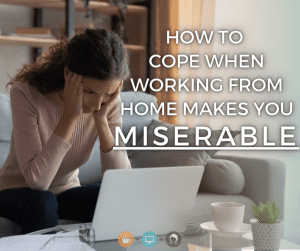How to Cope When Working from Home Makes You Miserable

You did it! After months (possibly years) of dreaming and planning, you finally made the leap and are now working at home–congratulations! You’re living the dream of a five-second commute, more time with your kids, and working in pajamas when the mood strikes. There’s just one problem: you are miserable.
Don’t despair. Any significant change can lead to a feeling of unease and even regret. But, take heart, with years of experience working from home and after talking to many others in your shoes, here’s my best advice for combatting your woes and emerging strong and confident in your decision to work-from-home.
Discover the True Issue
First, try to determine what’s wrong exactly. Change is tricky–even good change. And the adjustment period can feel like an eternity. Before you abandon your plan to work from home, take some time to assess what’s really bothering you. In my experience, it’s usually one (or a combination) of four things–growing pains, environmental issues, ambiguity about the decision, or unrealized expectations.
Growing Pains are Real
Starting a new job or making a radical change to your working conditions is bound to lead to growing pains. While uncomfortable, these pains are a normal part of the process. Even new projects that are outside your traditional wheelhouse can make you question your skills and choices.
When this happens, take a breath and reflect on the times you’ve felt this way in the past. New jobs and new skills take a while to develop. The discomfort is part of the growth process. You’re meeting new people, learning new ways of connecting, new systems, new skills, and new processes. It’s a lot to take in. Give yourself grace for slip-ups that might happen along the way.
If there’s one particular aspect of a new job that’s troubling you, consider ways to address it. For example, if learning a new technology is stressing you out, seek other ways to conquer it. Look for YouTube videos or webinars to help. Or, try setting small goals to make progress on specific elements of the transition.
When it comes to growing pains, they can be uncomfortable and can last a while–even up to a year for new jobs. But, just as surely as they are part of the process, they will surely fade. One day you’ll be doing the task that once caused you angst, and you’ll realize that you’ve grown into the role and feel confident in it. Look forward to that day and the renewed sense of wellbeing that comes with it. Until then, hang in there.
Spruce Up Your Home Office
Don’t underestimate how improving your physical workspace may enhance your experience and outlook. Transitioning to working-from-home often involves trial and error when it comes to your actual work setup. If you’re hunched over an ironing board trying to work in the dark closest, you are likely to be miserable.
Look around your house and consider if you might be able to set up a work location in a place that’s easier to work productively. Ideally, you can find a site that includes:
- Natural light or a place for suitable lamps.
- A roomy desk or table.
- A comfortable chair.
- A door that can be closed.
Once you have your spot, personalize it with plants, pictures, or artwork that you really like. Consider banning toys or kid homework from the space. All of these things can help make working from home more comfortable.
Banish Ambiguity
It’s natural to have second thoughts about any significant decision. But, nothing will sink your confidence faster than an endless round of asking yourself what if.
All the reasons you identified for wanting to transition to home-based work are still valid. And, in all likelihood, you’d be second-guessing your decision to work in the office, too. When you sense ambiguity rearing up, vanquish it by grounding yourself in all the reasons that led to your choice.
Check Your Expectations
When you consider any new adventure, you envision it unfolding in a certain way. Working from home is no exception. When considering the possibility, you probably saw yourself training for a marathon while living in a spotless house, with perfect children and a steadily growing career. In reality, you may be up before dawn, still wearing yesterday’s clothes, and finishing up a project while you dream about taking a shower. Both ways work, and the reality is that both scenarios may happen for you at any given time. Like life, working from home has ups and downs, and it tends to ebb and flow accordingly.
Embracing the real lived experience is the key to success here. Holding your day-to-day up to an idealized vision is a recipe for disappointment. Change your expectations to have a better experience.
Share Your Experiences
How have you battled the work-from-home blues? Drop a line and share your tips.
